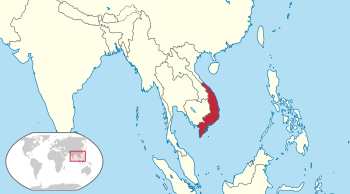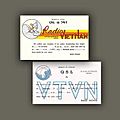South Vietnam facts for kids
Quick facts for kids
Republic of Vietnam
Việt Nam Cộng Hòa (Vietnamese)
|
|||||||||
|---|---|---|---|---|---|---|---|---|---|
| 1955–1975 | |||||||||
|
Motto: "Tổ Quốc – Danh Dự – Trách Nhiệm"
(English: "Fatherland – Honor – Duty") |
|||||||||
|
Anthem: Tiếng Gọi Công Dân
(English: "Call to the Citizens") |
|||||||||

Administrative territory of South Vietnam in Southeast Asia according to 1954 Geneva Accord
|
|||||||||
| Capital and largest city
|
Saigon | ||||||||
| Official languages | Vietnamese | ||||||||
| Recognised national languages | French | ||||||||
| Religion |
|
||||||||
| Demonym(s) | South Vietnamese | ||||||||
| Government |
|
||||||||
| President | |||||||||
|
• 1955–1963
|
Ngô Đình Diệm | ||||||||
|
• 1967–1975
|
Nguyễn Văn Thiệu | ||||||||
|
• 1975
|
Trần Văn Hương | ||||||||
| Prime Minister | |||||||||
|
• 1963–1964 (first)
|
Nguyễn Ngọc Thơ | ||||||||
|
• 1975 (last)
|
Vũ Văn Mẫu | ||||||||
| Historical era | |||||||||
|
• Referendum
|
26 October 1955 | ||||||||
|
• 1963 coup
|
2 November 1963 | ||||||||
|
• Paris Peace Accords
|
27 January 1973 | ||||||||
| 30 April 1975 | |||||||||
| Area | |||||||||
|
• Total
|
173,809 km2 (67,108 sq mi) | ||||||||
| Population | |||||||||
|
• 1955
|
12,000,000 | ||||||||
|
• 1974
|
19,582,000 | ||||||||
| Currency | đồnga | ||||||||
| Time zone | UTC+8 (Saigon Standard Time (SST)) | ||||||||
| Driving side | right | ||||||||
|
|||||||||
| Today part of | Vietnam | ||||||||
South Vietnam, officially called the Republic of Vietnam, was a country that existed from 1955 to 1975. It was located in the southern part of Vietnam. During the Cold War, South Vietnam was part of the Western Bloc. This meant it was allied with countries like the United States.
Its capital city was Saigon, which is now called Ho Chi Minh City. South Vietnam shared borders with North Vietnam to the north, Laos to the northwest, and Cambodia to the southwest. It also had a coastline along the South China Sea.
Contents
What Was South Vietnam?
South Vietnam began as the "State of Vietnam" in 1949. It was a self-governing area within the French Empire. In 1955, it changed its name to the "Republic of Vietnam."
How South Vietnam Started
The Republic of Vietnam was officially created on October 26, 1955. Ngô Đình Diệm became its first president. Before this, he had served as a leader under Emperor Bảo Đại.
Many countries, including the United States, recognized South Vietnam as an independent nation. It tried to join the United Nations, but its application was blocked in 1957.
The history of South Vietnam goes back to a French colony called Cochinchina. This area covered the southern part of Vietnam. After World War II, a group called the Viet Minh, led by Ho Chi Minh, declared Vietnam independent in 1945. They formed the Democratic Republic of Vietnam in Hanoi.
The Vietnam War and Its End
In 1949, some Vietnamese politicians who were against communism formed a different government in Saigon. This government was led by former emperor Bảo Đại. However, in 1955, Prime Minister Ngô Đình Diệm removed Bảo Đại from power. Diệm then became president after a public vote.
In 1963, President Diệm was killed during a military takeover. After this, several military leaders ruled the country for short periods. General Nguyễn Văn Thiệu became president in 1967 and led South Vietnam until 1975.
The Vietnam War began in 1955. It started with an uprising by the Viet Cong, a group supported by North Vietnam, China, and the Soviet Union. The United States got involved in 1965. They sent many soldiers and military advisors to help South Vietnam.
The fighting became very intense. In February 1968, during the Tet Offensive, there were over a million South Vietnamese soldiers and 500,000 US soldiers in South Vietnam. The war changed from a guerrilla fight to a more traditional war.
Even after a peace agreement was signed in Paris in January 1973, the fighting continued. In 1975, the North Vietnamese army and the Viet Cong launched a large attack. They took over Saigon on April 30, 1975. This event marked the end of the Republic of Vietnam.
On July 2, 1976, South Vietnam and North Vietnam officially joined together. They formed one country called the Socialist Republic of Vietnam.
Images for kids
-
US President Dwight D. Eisenhower and Secretary of State John Foster Dulles greet President Ngô Đình Diệm of South Vietnam in Washington, 8 May 1957.
See also
 In Spanish: Vietnam del Sur para niños
In Spanish: Vietnam del Sur para niños








